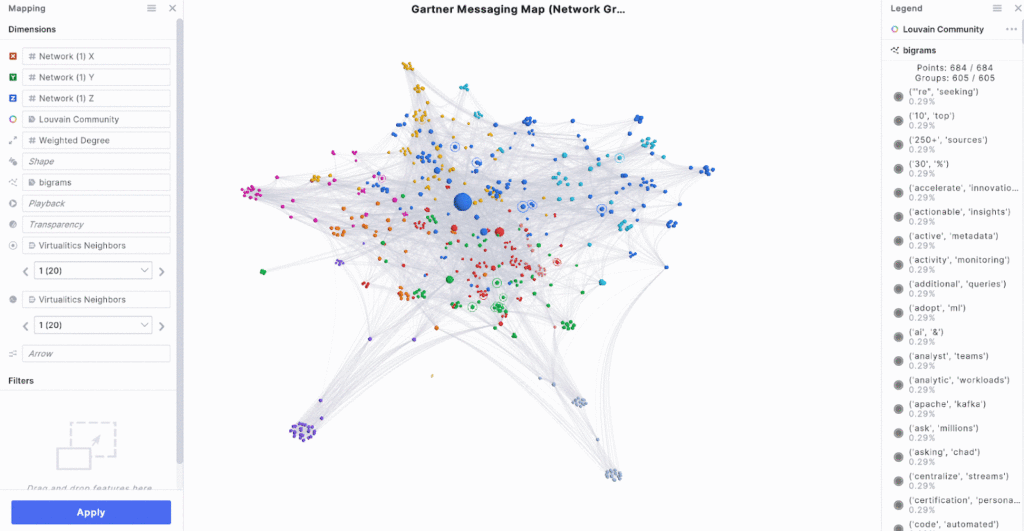We were just at the 2023 Gartner Data and Analytics Summit, which is always a valuable opportunity to hear directly from data scientists and analysts… and they sure had questions. The biggest one was “What do all these vendors mean when they say they have ‘AI’ and what does this mean for me?”
Buzzword Bingo on the Show Floor
With hundreds of vendors on the show floor and a huge number of presentations and panels, we heard and saw a lot of different words used to describe data, analytics, and AI. Many visitors to our booth expressed confusion or trepidation around the things they were hearing, unsure if everyone who mentioned AI was doing the same thing or not. (Spoiler alert: they’re not.)
We wanted to take a closer look so we did an unofficial survey of the language that’s being used by the industry around data analytics. We took notes on all of the slogans and catchphrases at the conference, built a spreadsheet, and then analyzed the words and phrases we recorded. We did some quick data prep in Python (for a larger dataset we’d recommend using our in-platform NLP application) and then used our Python API to pass the data into the Virtualitics AI Platform. There we used our patented Network Extractor to create a network of the words and phrases. Our Network Extractor can relate companies together based on what verbiage they use to market themselves.
Let’s talk about some interesting trends we found.
Words that companies in various industries are using often formed a cluster (or community) and had a lot of connections to other phrases, reflecting the fact that their use was not tied to a solution or problem (in graph analytics, the community with the most connections is known as the most influential community):
- Accelerate Innovation
- Consumers Owners
- Domain Experts
- Easiest Way
- Go Beyond
- Insight Works
- Reducing Costs
- Unified Platform
Clusters were also found in a subset of data companies that were using a different set of terms frequently (these are known as tightly knit communities). This group prefers a different set of common phrases:
- Knowledge Graphs
- Active Metadata
- Adopt ML
- Database compliant
- Dev Tool
- Entire Organization
- People Together
- Saas Environment
One of the most prominent phrases in both groups we studied was “Data [insert your favorite buzzword here]” which included data quality, data integrity, data complexity, data apps, data processes, and data silos. About what you would expect for a data and analytics conference, and yet we know that overexposure to this type of messaging causes it to lose meaning.

When you’re at the Gartner Data and Analytics Summit you know we’re there to talk about data. But that doesn’t keep us from repeating that message, a lot. The center node here represents the word “data” and it’s clear to see that many other nodes connect back to it.

How are those companies using data in their messaging to talk about their products and capabilities? Our network graph allows us to select specific nodes, explore how they relate to other companies, and see how all of us are connected by our data messaging.
“Insight” is another overused expression in data and analytics, and when we focus in our network graphs on the word, we unsurprisingly see a lot of commonalities. Words like “actionable” or “critical” are often connected with insights, as are verbs like “get” or “deliver” in the same combination. We found that 64 companies featured the word “data” or “insights” in their messaging and 18 companies used them both.

Our AI Insights identify the most impactful communities in our network so we can quickly identify their significance. Here you can see those communities being highlighted when we select an Insight Card so we can dive deeper into our network graph.
Reading the same general message over and over does nothing to help understand the purpose of these many products in the data and analytics space. It’s bound to cause confusion, and it was clear to our team that the language a lot of tech companies are using is doing just that at every stage of the customer journey. In a recent interview on the Intelligent Exploration Podcast, Justin Smith, Ph.D. talked about the common language in AI analytics and business…or the lack thereof:
“There’s no common language that exists today… to concretely talk about the ideas that we’re exploring through machine learning and AI. So we have to get to the whiteboard and draw it out. We have to say, when you say the word “risk”, what do you mean? Define that for me, because I might be saying the word “risk”, [and] it means something completely different. And that’s okay. We just have to acknowledge that. And then [determine] how do we meet them where they are and speak a language that you can both speak and understand each other?”
Justin’s example of “risk” is a perfect illustration of a word that everyone thinks they understand but can mean so many different things. If a simple concept like risk can get tangled up, imagine the potential for misunderstanding with “AI,” “automatic,” or “insights.”
Add ChatGPT and Stir Things Up
An additional contributor to the messaging confusion was a marked increase in the number of vendors and sessions talking about AI compared to just seven months ago at the 2022 Gartner Summit. For a lot of vendors, this seemed to mean surface-level query abilities that were tied into ChatGPT. The phrase “ChatGPT” was certainly getting lots of attention, but what was less clear was just how useful it would be embedded in a data and analytics tool.
ChatGPT has launched AI to the mainstream but in doing so has managed to overshadow the more nuanced AI conversation—and we saw that reflected in the questions we had from visitors to our booth. When you’re talking about data and analytics, AI is something to be created following diligent development and testing, but it’s also a tool that can be used to explore the data to begin with. ChatGPT, a large-scale Natural Language Processing model, can layer in as a tool to help users interact with a system using natural language. But it’s absolutely not suited to do data analysis for a business.
Besides, even if you could ask ChatGPT to analyze your latest sales data or supply chain network, you won’t have the necessary insight into the answer to be confident in the analysis. Bryan Katis, our Head of Product, says “Building trust is critical for gaining confidence with the business when utilizing AI, and that starts with explainability to avoid any potential bias. This is one of the key challenges with Generative AI and ChatGPT that enterprises will need to overcome.”
But the shortcomings of the current iteration of ChatGPT don’t mean that AI as a whole is not a useful tool for analytics. Data scientists have been using AI algorithms to analyze complex data for ages! The ability of AI, combined with some computing power, to sift through mass amounts of data and find connections makes it perfectly suited for data analysis.
Much like ChatGPT made natural text processing accessible, Virtualitics has made exploratory AI accessible. It’s a cornerstone of the Virtualitics AI Platform and the power behind Intelligent Exploration. Using AI specifically designed to explore and explain complex data, Intelligent Exploration analyzes vast, complex datasets, applies an intuitive visualization, and generates explanations for what was discovered. Our AI isn’t a “black box” that gives you an answer that you can’t source or investigate, it’s your assistant to get through the slog of data and make it to the parts you can put to work.
This is what we mean when we say that AI is an integral part of our platform. We believe that using our AI to thoughtfully explore business problems will help organizations who want to create AI models of their own.
Cutting through the hype to the real language of AI Analytics
When you’re looking for tools and platforms that could help your data scientists and analysts, it’s important to ask clarifying questions about the software, processes, and algorithms to make sure everyone is in agreement on what statements like “AI” and “automation” really mean.
No pressure, right?
Don’t worry, we have some questions to get you started. You might need to ask:
- How is my data prepared and integrated?
- Who on my team is going to be able to use this right away? Would it be possible to train those who aren’t data analysts to use it?
- How many attributes can an analyst explore at once?
- How is my massive data set processed and sampled?
- Do I have to be able to write code to prepare or merge data?
- How well can you visualize interrelated data?
- How are you validating and explaining the answers from your AI systems?
- Do you have the capabilities to explain model outputs and understand and visualize where the limitations of your algorithms are?
- How do you know if the patterns you are finding are statically significant?
What can AI do for advanced data analytics?
It’s important to us that users feel comfortable and confident in the processes and solutions that they bring to their data analytics teams. We invite you to expand your AI analytics vocabulary by downloading our free e-book on Intelligent Exploration to learn more about how Virtualitics is leveling up data exploration!







